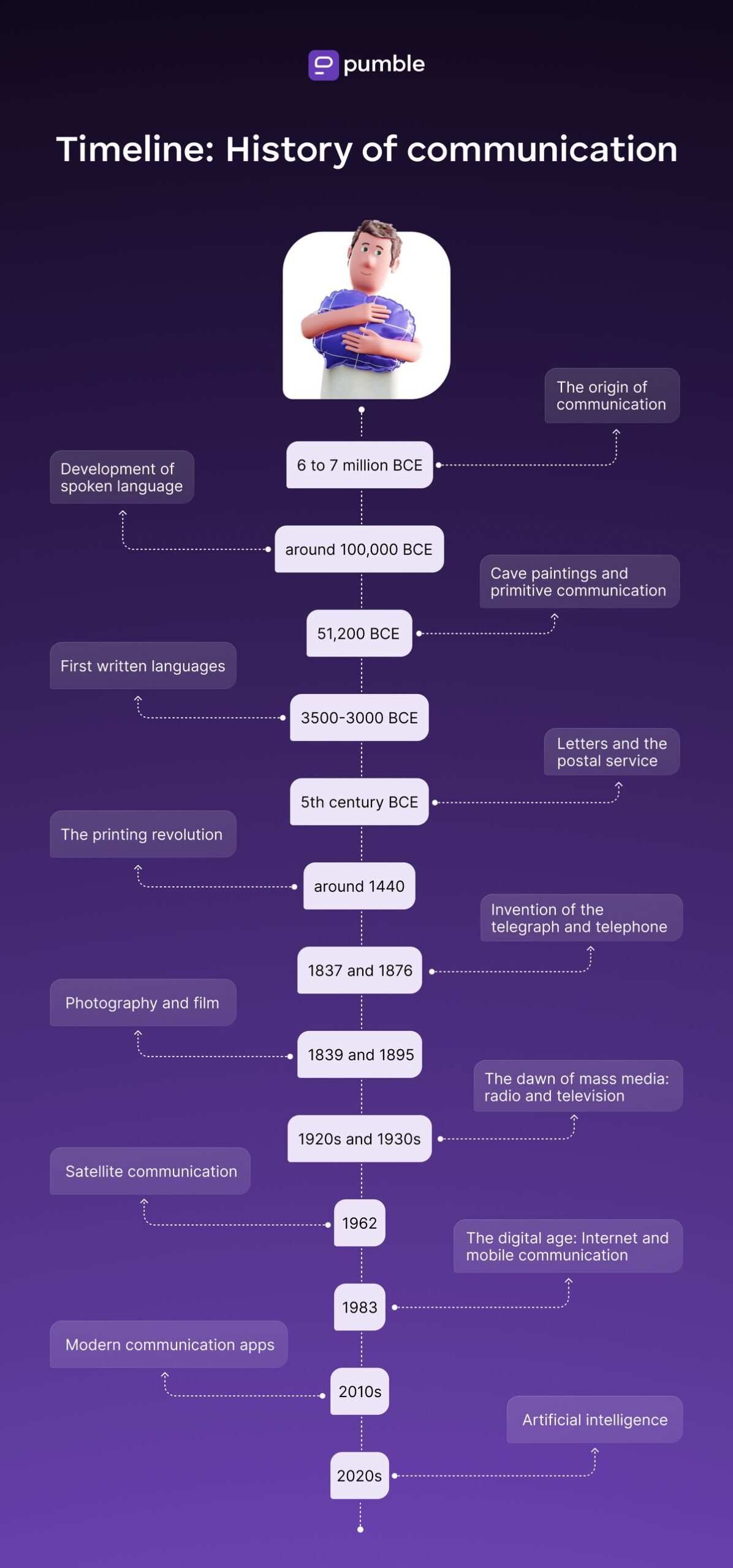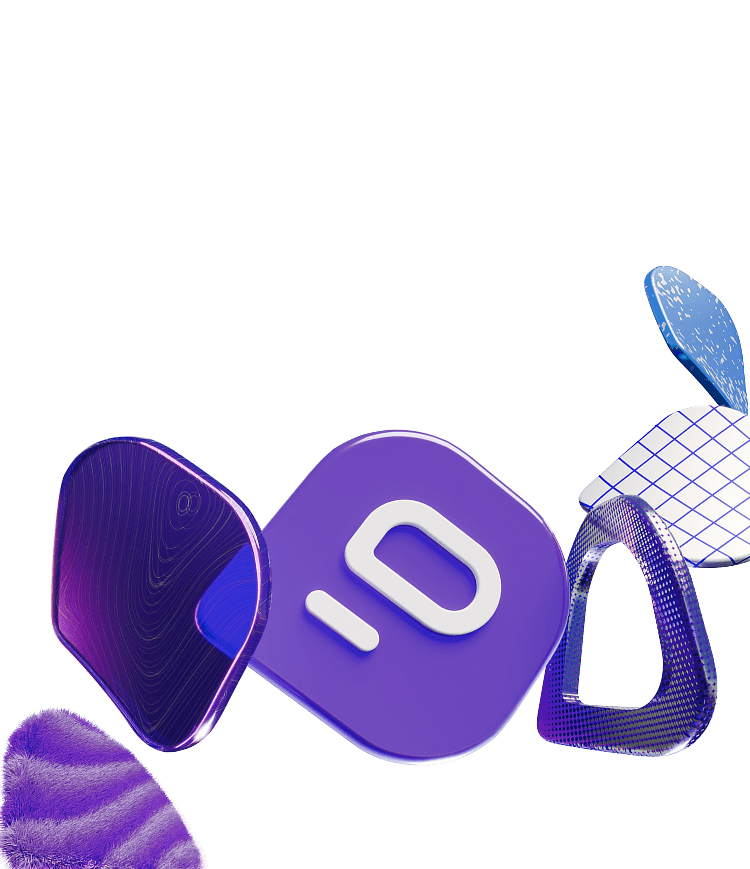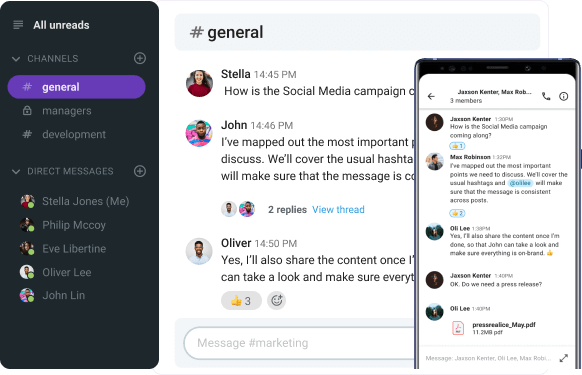The evolution of communication has been in constant motion since the ancient beginnings of our species.
In this article, we’ll tell you the story of what happened along the way, and how that great journey impacted our communication habits today.
This is a story about us, humans, and the tremendous things we can achieve when our capacities are aimed in the right direction.
We’ll cover all the major milestones in communication history, from its prehistoric inception, across centuries, all the way to the information age and the team communication apps of the present day.
Let’s go on a journey and uncover how our ways of communication evolved alongside the advancement of our civilization.

Table of Contents
Historical background: The communication timeline
From its very conception, human communication was a necessity for our survival.
As society developed, communication gradually evolved to enable different endeavors that shaped our civilization.
Here’s a timeline showing the gradual progress all the way from smoke signals and pigeon messengers to mass emails and satellite communication.

The origin of communication
Period: 6–7 million BCE
Nonverbal communication is as old as the first ape-like creatures who could habitually walk on two legs. The shift to bipedalism occurred roughly 6 to 7 million years ago.
It seems our ancestors functioned by using gestures, non-verbal expressions, and body language — and went millions of years before they developed the ability to vocalize and produce sounds.
The development of spoken language was the first monumental leap in human communication. It emerged roughly around 100,000 BCE.
Our rudimentary speech system consisted of simple sounds, followed by non-verbal gestures, used to denote some things humans considered important in this period.
Early human ancestors likely paired simple sounds with specific gestures (like looking up or pointing) to communicate about immediate, important survival threats, long before the development of complex grammar.
Our closest relatives, primates, have been observed to use distinct sounds: a “bark” for leopards, a “cough” for eagles, and “chutter” for snakes.
While the exact timeline is still debated, the emergence of complex vocal communication allowed early humans to cooperate, share knowledge, and build social structures in ways previously impossible.
Cave paintings and primitive communication
Period: 51,200 BCE
The language system our distant ancestors used wasn’t very suitable for long explanations and oral lore. That’s where cave drawing came in.
Drawings allowed humans to leave messages that could be stored and viewed by other humans across time.
Our distant ancestors depicted situations from their everyday lives on cave walls in great detail. This way, they left a trace to future generations, so they would know what to be wary of (like predators) or what to do in particular situations (such as ceremonies).
Cave paintings proved to be the most long-lived form of communication. Many of them are still standing on cave walls all over the world — the oldest one that we know of is 51,200 years old.
However, cave paintings weren’t the only type of drawings our ancestors practiced.
A few thousand years after cave paintings, our ancestors started to incise and carve pictures into rocks.
Gradually, throughout thousands of years, civilizations worldwide started to develop their own systems of symbols and characters that denoted objects, thoughts, or feelings.
These carvings were a fundamental communication tool for many centuries. Some tribes even used similar ancient forms of communication until the 19th and 20th centuries, before their communication systems evolved thanks to their contact with the rest of modern civilization.
These communication methods paved the way for the development of more advanced language and communication systems that appeared around 3500 BCE.
Communicate and collaborate with your team in real time with Pumble
The invention of writing and the first written languages
Period: 3500–3000 BCE
The earliest forms of writing are actually “proto-writing” systems — systems of symbols that represent objects, numbers, or names, but didn’t capture the full grammar and syntax of a spoken language.
These evolved into true writing systems over time.
This was a revolutionary step in human evolution because it allowed for the recording of information, laws, and history on a permanent medium like clay tablets. For the first time, knowledge could be stored and transmitted across time and space without relying on memory.
This slowly led to the rise of complex civilizations, organized governance, and the preservation of culture.
However, we would have to wait a few thousand years for the first official language and writing systems to appear.
Of course, there are ongoing debates about which system appeared first.
Many historians and researchers agree that the first writing system was Sumerian.
However, research also suggests that people in Egypt and Mesoamerica simultaneously developed their own writing systems alongside those in Sumer.
Sumerians used a cuneiform script that consisted of symbols and characters that denoted words. Clay tablets that have been found and preserved witness how well-developed the Sumerian language was at that time.
This allowed Sumerians to develop various aspects of their lives, including invoicing and transactions, for example.
However, the oldest complete sentence scientists found wasn’t written in Sumerian. It was actually found in Egypt, and it was written in Egyptian hieroglyphs around the same time when famous Sumerian clay tablets were being created.
Therefore, the debate is still open, especially considering that many older languages from the Afroasiatic family have become extinct over time.
Let’s take a look where the development of written languages took us next.
Letters and the postal service
Period: 5th century BCE
Long before electricity, the formal establishment of postal systems was a revolutionary substep in the history of communication.
One of the earliest and most celebrated postal systems was the Persian angareion, which dates back to the 5th century BCE.
Other services, like the one established by Augustus in Rome around 20 BCE or the modern postal system of the 19th century, also created a reliable, affordable network for personal and commercial communication.
This was especially inspiring because it allowed everyday people to maintain meaningful connections across vast distances.
The simple act of receiving a letter meant that:
- People could sustain relationships and families could stay connected.
- Businesses could correspond, send invoices, and receive orders reliably, which simplified trade.
- Ideas could spread more quickly, which made the postal service a crucial tool for organizing social and political movements.
In the past, paper was a precious and expensive resource. That’s why people developed a commonly used technique of “cross-writing”. After filling a page, the writer would turn it 90 degrees and continue writing over the original lines, forming a grid. The text was difficult to read, but the cost of buying a second sheet was saved.
In a world of instant messages, the postal service now represents a true testament to the power of physical and asynchronous communication, as well as the intimacy and preciousness of words written by hand.
Communicate asynchronously with Pumble
The printing revolution
Period: Around 1440
Jumping in time quite a bit, we’re flying through centuries from the first languages, written systems, and first letter couriers to see how humans preserved language.
While many languages appeared and vanished quickly, a lot of them survived and further evolved — for example, Arabic and Hebrew, which are the oldest existing languages, according to many scientists.
However, we probably wouldn’t know any of that or have any information about the oldest languages and manuscripts if there hadn’t been an invention that changed the world — the printing press.
Up to this point in history, every book was a luxury item copied by scribes by hand. Written knowledge was often exclusively available to the church and the wealthy few. Literacy was extremely low, and even the literate people couldn’t really rely on the information found in hand-copied books, as hand copying often introduced new errors with every iteration.
The first movable typing machine was invented in China in the 11th century and developed further by the Chinese and Korean people in the following few centuries.
It enabled easier production of letters and books, which led to better communication and education.
All these inventions in the field of printing prepared the terrain for the invention of the printing press.
The printing press, invented by the goldsmith Johannes Gutenberg in 1440, marked the beginning of the Printing Revolution.
Gutenberg’s invention:
- Sparked a surge in literacy,
- Fueled the Renaissance and the Reformation, and
- Paved the way for the scientific revolution by allowing for the rapid spread of new ideas and discoveries.
Eventually, the Printing Revolution led to advancements in science, larger production of now world-famous literature, and the invention of the first printed newspapers in the 17th century. Knowledge became way more accessible.
Thanks to printing, people were able to:
- Communicate their messages across the world,
- Share ideas across borders, and
- Standardize language – by creating identical copies of texts, which allowed for spelling, grammar, and syntax to become uniform.
The invention of printing was just the beginning of the great things humankind would do in the years to come.
The invention of the telegraph and telephone
Period: 1837 and 1876
The electrical age of communication began with the inventions of telegraph and telephone. This allowed information to travel at the speed of electricity — an unprecedented pace for the 19th century.
Patented by American inventor and painter Samuel Morse in 1837, the telegraph revolutionized news, commerce, and warfare.
The telegraph used patterns of electrical pulses that were translated using Morse Code, developed by Samuel Morse and Alfred Vail. Short clicks (dots) and long clicks (dashes) were combined to represent letters and numbers.
On May 24, 1844, Morse sent the first public message from Washington, DC, to Baltimore — “What hath God wrought.”
In the following years, the telegraph became a widely-used means of communication around the world.
Next came the telephone. On March 7th, 1876, Alexander Graham Bell claimed that he invented a device called a telephone that allowed him to transmit his voice over long distances and hear it through another device.
Of course, the development took two years of focused and intensive work.
But on that faithful March day, Bell’s lawyer raced to the U.S. Patent Office in Washington, DC, to beat the lawyer of Elisha Gray, another inventor who worked on the same invention independently. Bell’s lawyer patented the revolutionary idea of using a continuous, variable electrical current that mimicked the vibrations of sound waves – enabling it to transmit the human voice to the other side.
Three days later, Alexander Graham Bell was able to successfully demonstrate his invention with the help of his assistant.
While testing the telephone between two separate rooms, Bell said the famous words: “Mr. Watson, come here. I want to see you,” to his assistant, Thomas A. Watson, who — to his astonishment — heard him loud and clear.
This simple call was the first successful demonstration of the telephone, proving that Bell’s patented concept worked.
The telephone personalized long-distance communication by transmitting the human voice. This further “shrank” the world and bridged distances, by connecting people in a more immediate and personal way.
Photography and film
Period: 1839 and 1895
The camera’s forerunner, camera obscura (latin, “dark chamber”), evolved in a few phases through history. The earliest and most notable one came from Louis Daguerre, a professional theatre scene painter from Paris.
The first practical photographic process, called the daguerreotype, was introduced in 1839 by Daguerre at a meeting of the French Academy of Sciences in Paris. Daguerreotype worked by capturing light on a chemically treated silver-plated copper sheet.
The evolution of photography
Photography evolved over the following years, largely improved by Antoine Claudet, who opened a studio on the roof of the Royal Adelaide Gallery in June 1841.
The invention of photography was a monumental leap in communication, as it allowed for realistic visual communication — moments in time could be preserved with objective accuracy.
Photography influenced:
- Journalism, as photojournalism brought the grim realities of war and distant events to the public,
- Personal history, as families could now keep visual records of their loved ones and their lives, and
- Science and exploration, by allowing precise documentation of new discoveries.
The rise of film
Film took this a step further by capturing motion, giving rise to an entirely new art form and a powerful medium for storytelling that transcends language barriers.
The invention of film was possible because of the confirmation of persistence of vision. When our eyes see a series of still images in rapid succession (today, typically 24 frames per second), our brain blends them together, creating the illusion of seamless, continuous motion.
Though a few experiments preceded the creation of film, the event history often refers to December 28th, 1895 as the birthdate of film.
That day, French inventors Auguste and Louis Lumière used their invention, the cinematograph, to hold the first commercial film screening for a paying audience in Paris. This was the first communal movie-watching experience.
Film’s ability to tell a story through moving pictures had (and still has) a profound and lasting impact on society and communication. The invention of film brought:
- Universal storytelling. In the era of silent films, movies were an almost universal language. They could convey complex narratives, humor, and deep emotion across cultural and language barriers.
- Creation of mass culture. For the first time, millions of people in different cities and countries could have the exact same shared cultural experience by watching the same movie. This created international celebrities, fashion trends, and a global pop culture that wasn’t possible before.
- Persuasion and propaganda. Governments quickly realized film’s power for propaganda during World War I and II, using newsreels and movies to shape public opinion, boost morale, and demonize the enemy. It also became the most powerful advertising medium ever created.
- A new art form. Directors could manipulate time (through editing), perspective (through camera angles), and emotion (through music and the actor’s performance) to create entirely new worlds and tell stories with a previously unimaginable depth.
Around the same time, two new inventions also brought unprecedented speeds to our communication process — radio and television.
Radio and television: The dawn of mass media
Period: 1920s and 1930s
The 19th and 20th centuries saw the acceleration of mass literacy, thanks to the inventions we previously mentioned. Next came the radio and television, which ushered in the era of mass media.
The invention of the radio made it possible to transmit sound instantly over vast distances without wires, significantly overcoming the obstacles of geography.
Nikola Tesla, a Serbian-American inventor was the first to make a wireless radio, and he publicly demonstrated it in March of 1893.
In 1899, Guglielmo Marconi sent and received the first radio signal communication across the English channel. On December 12, 1901, Marconi flashed the first wireless radio signal across the Atlantic Ocean.
It took two more decades of scientific research and development before the radio was born and started moving into households worldwide.
From the 1920s onwards, voices could finally be broadcast live into the homes of millions.
Radio became the first electronic mass medium. Families would gather to listen to news, stories, and music, and a sense of national identity and shared culture emerged. News of major world events could also be spread in real time.
Television soon followed.
On September 7, 1927, Philo Farnsworth transmitted the first all-electronic television image through a simple straight line.
A little less than a decade later, in 1936, the BBC launched the world’s first regular, high-definition public television service.
Television added the power of moving pictures to the shared experience radio introduced. This affected politics, entertainment, and advertising. Seeing world events like the moon landing or global crises unfold in real time, created a new sense of global connection.
Radio and television dominated the 20th century, but another kind of mass media was on the horizon.
The digital age: Internet and mobile communication
Period: late 20th and 21st century
For centuries, people relied on printed reading materials, television, and radio to remain informed.
However, the 20th century brought with it World Wars I and II, as well as the Cold War (along with all of their atrocities). With these events came the rapid technological changes and advancements — and competition between countries happened right alongside it.
This rivalry between superpowers enabled us to see a man on the moon, satellites in space, and the appearance of the ideas and technologies that gave rise to the Internet.
The Internet appeared in 1983, and communication between people became much easier, as telephone calls were no longer the only way to connect with people around the world.
Initially a military project called ARPANET, the Internet rapidly evolved into a global network connecting billions of people — and it continues to grow each day.
The invention of the World Wide Web by Tim Berners-Lee in the 1990s made the internet accessible to the public, leading to an explosion of information sharing, social networking, and e-commerce.
All of the technological advancements from the 80s until the present day, brought humanity into a period scientists label the information age.
Mobile phones and smartphones
The development of mobile phones, and later smartphones, untethered communication from a fixed location.
Today, phones provide constant access to information and allow for instant communication through voice, text, and video, which shapes our social interactions and daily lives.
The major milestones in the evolution of mobile phones and smartphones include:
- 1983: The first commercially available handheld mobile phone is released, the Motorola DynaTAC 8000X, often nicknamed “the brick”.
- 1996: The introduction of the flip phone, popularized by the Motorola StarTAC.
- 1994: IBM Simon Personal Communicator is released. It had a touchscreen and could send and receive emails and faxes.
- 2007: The first iPhone is introduced.
- 2008: The first commercially available smartphone running the Android operating system is introduced — the HTC Dream.
After this, the market and the competition slowly influenced the development of more sophisticated phones with improved systems specifications and capabilities.
Satellite communication
The telegraph and telephone cables crossed oceans, but satellite communication truly erased borders and created what Marshall McLuhan called the global village.
Although created before the internet, paired with it, satellite communication became the communication powerhouse that we know it for today.
Many satellites orbiting the Earth in the present act as wireless mirrors in the sky, bouncing signals from one point on the globe to another.
This technology enables:
- Live global broadcasts — Events like the Olympics or royal weddings can be watched live by a global audience simultaneously.
- Reliable transoceanic calls — International phone calls are much clearer, more common, and more accessible.
- Modern navigation — The foundation for the GPS in our phones and cars comes from satellites.
- Connecting remote places — Satellites provide internet and communication access to remote parts of the world, where physical cables can’t reach.
Modern communication apps
For a few decades, computers were in the exclusive domain of experts and “nerds” who could speak their complex, text-based language.
The philosophical upgrade to the GUI transformed the computer from an overwhelming machine for calculation into a tool for creation, creative expression, and communication.
At the end of the 20th century, the first social networks appeared and took the world by storm. It was just a matter of time before some messaging apps designed specifically for business communication would appear.
Before the 2010s, team messaging apps had already been available on the market for a few years. Still, they were lacking some vital features.
For example, although there were apps that had some sophisticated features such as screen sharing in 2009, the chats and interface in general weren’t organized in a way that suited the users who needed them for work.
Because of this, the 2010s saw the birth of the first instant messaging apps intended solely for businesses.
The apps offered features such as:
- Chat rooms (channels),
- 1-on-1 messaging,
- File storage,
- Voice calls,
- Searchable chat history,
- Video calls,
- Screen sharing, and many other features.
But this was just the beginning. Today, most modern companies create internal knowledge bases in apps by relying on shared files accessible to all employees, just one search away.
This represents a core change in how we create, validate, and share information.
From the 2010s onwards, business messaging apps have continued to develop, and they have become a vital part of the business world and a crucial means of communication.
Searching for a reliable communication app? Try Pumble
Evolution of workplace communication: How the apps took over
Around the mid-2010s, many businesses underwent a digital transformation process that allowed them to “take their offices online”.
A task that seemed impossible just a few decades ago was made feasible thanks to contemporary business messaging apps that allow us to connect and communicate with colleagues and customers online.
Being online on apps like Pumble is the closest we can get to the feeling of being in the office and communicating in real time.
Even though business communication apps allow us to connect with others remotely, it’s unclear whether business messaging apps would be so popular if not for the COVID-19 pandemic that transformed the way we work.
During and after the pandemic, many companies introduced remote or hybrid work policies that allowed employees to work from home. Many companies realized that working from home was possible, and, in many cases, beneficial both for companies and employees.
So, in 2020, the popularity and use of employee communication apps soared, as everyone needed a solution that would allow them to stay in touch with their teams and maintain pre-pandemic levels of productivity.
The impact of technology on communication
Since communication is constantly evolving, it’s hard to say what the future holds with complete certainty.
Today, we’re all walking with a device that gives us access to a near-infinite library of human knowledge in our pockets — something we couldn’t even imagine possible a couple of decades ago. What’s more, smartphones and the internet have become a type of an extension of human consciousness.
Throughout history, every communication evolution milestone had one thing in common: it reduced the time required for information to be sent and received.
The ordinary individual today can distribute information more quickly than a world leader could less than 50 years ago. Communication is almost instantaneous.
But even this isn’t the end of our communication journey. Upcoming technology advancements will profoundly impact how we work, behave, and even think — thanks to AI.
Artificial intelligence and the future of communication
The development of artificial intelligence in recent years has sparked conversations that imply the end of the information age, and the beginning of the age of intelligence.
Large language models (LLMs) are capable of bridging the gaps between different languages. They can fetch information from sources all around the world and compile them into a straightforward answer, with varying levels of complexity.
Users across the world rely on these AI-powered tools to speed up research and automate repetitive cognitive tasks, such as writing emails, summaries, and similar.
The highly tailored responses available in AI chatbots can answer questions regarding orders, products, and services, and even anticipate the user’s needs based on past interactions.
However, AI is far from perfect, and many LLM users have warned against blindly trusting AI.
As Kurzgesagt’s YouTube video essay suggests, relying too heavily on artificial intelligence can create a feedback loop of falsely distributed information — be it half-truths or straight up false facts.
For example, creators that rely on half-truths and made up info acquired from AI can post their content, leaving it for an LLM to find it again after another user’s query. The LLM then deduces that this information is simply confirmed by another source, takes it as fact, and serves it as relevant again.
So, in a few years, there’s a chance we won’t be able to differentiate truth from lies in an online space. Hopefully, a measure to counter this will be placed in time.
In regards to the communication apps that promote communication between humans, the future seems a little bit more predictable and less grim.
Given that communication apps have become established in our lives, living and working without at least one such tool will probably be less likely every day, especially as more businesses start integrating them in their daily workflows.
It is likely that more and more communication apps will start popping up as time goes on, which will promote competition and also encourage apps to adapt to the needs of users.
On the other hand, making the right choice for your business will probably become more difficult with so many options available.
However, the perfect solution for your team might be closer to you than you think.
Pumble: the app that incorporates our best communication achievements
Pumble is a business messaging app that serves as a library of knowledge that has the capability to replace your work phone, file database, email, and even your office and conference room.
Some of Pumble’s main features include:
- Channels and DMs — which enable quick and smooth communication between colleagues,
- Video conferencing — to meet with colleagues and partners from all over the world,
- Screen sharing — to showcase important details to your remote colleagues,
- Guest access — to include customers and external collaborators into your workplace communication,
- Threads — which keep all conversations structured and easy to follow, and
- File sharing — which allows you to build your company’s internal knowledge base.
Pumble takes great pride in its unlimited search history on all plans, which allows you to access files, messages, and documents in your company’s vast shared library of knowledge at any time.

They say you should learn history, or you’ll be doomed to repeat it.
Here at Pumble, we take that seriously, which is why we always strive to be better. Continuous improvement of our app is our constant goal — as shown in the Pumble roadmap.
Thanks to its all-encompassing and affordable pricing plans, Pumble is becoming an increasingly popular solution for businesses.
And, if you are interested in transforming your communication by integrating it with time tracking and task management, you can try the CAKE.com Bundle.
It seamlessly integrates Pumble with Clockify, our time-tracking app, and Plaky, our project management tool.







